Reducing Smoking in Newham: Public Health Strategies and Challenges
VerifiedAdded on 2023/06/12
|20
|6186
|343
Essay
AI Summary
This essay examines the public health strategies aimed at reducing smoking in Newham, a borough in London facing significant challenges related to inequity and poverty. It highlights the role of depression and schizophrenia as key variables influencing smoking habits, and explores the impact of socioeconomic inequalities on health outcomes. The essay discusses Public Health England's (PHE) initiatives, including tobacco control plans focused on reducing exposure to second-hand smoke, increasing tobacco prices, and regulating tobacco promotion. Challenges associated with implementing these strategies, such as treatment costs and economic impacts on tobacco companies, are also addressed. The importance of health promotion and inter-professional collaboration in achieving a tobacco-free society is emphasized, along with the advantages and disadvantages of collaborative practices in social and health care. The essay concludes by advocating for continued efforts to support smokers in quitting and to promote overall public health in Newham.
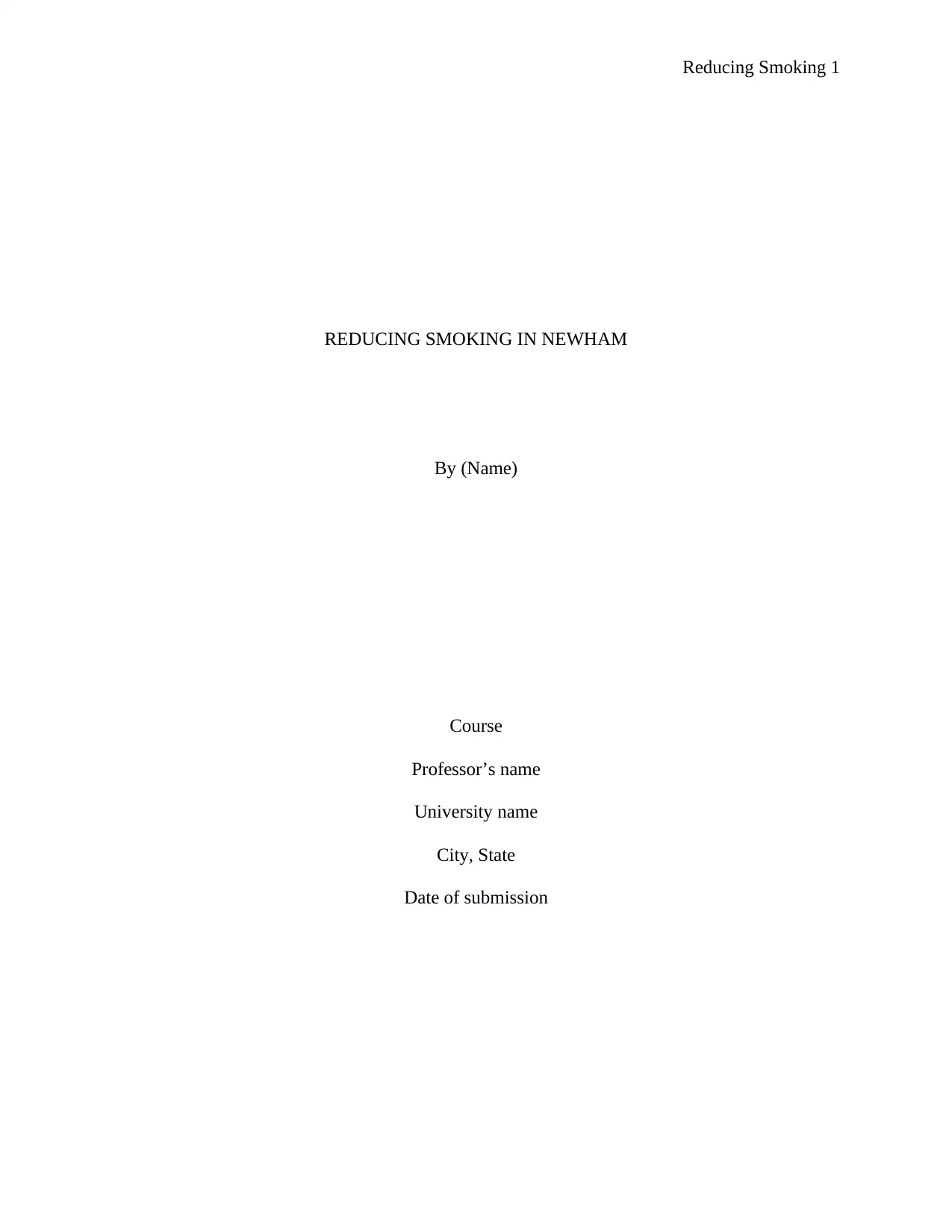
Reducing Smoking 1
REDUCING SMOKING IN NEWHAM
By (Name)
Course
Professor’s name
University name
City, State
Date of submission
REDUCING SMOKING IN NEWHAM
By (Name)
Course
Professor’s name
University name
City, State
Date of submission
Paraphrase This Document
Need a fresh take? Get an instant paraphrase of this document with our AI Paraphraser
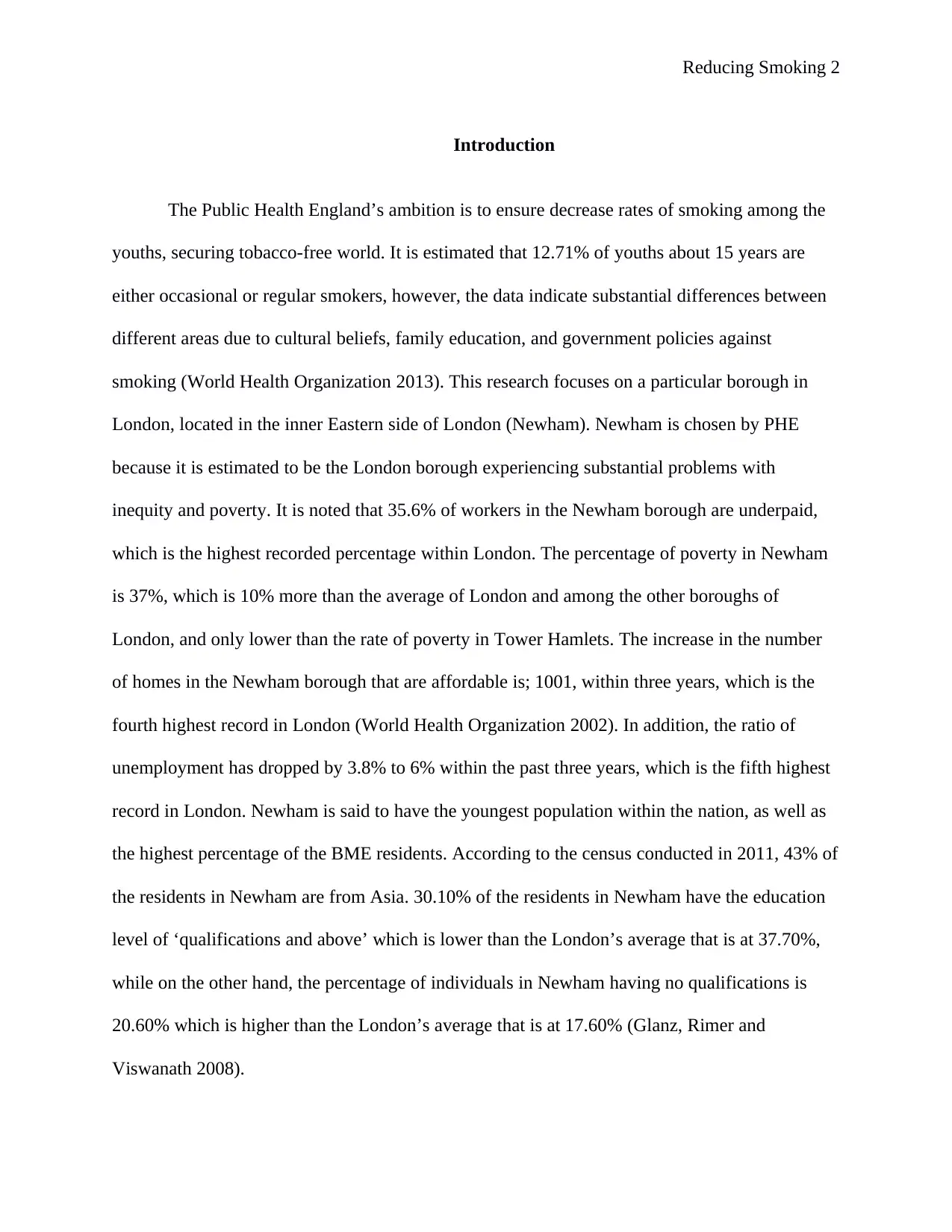
Reducing Smoking 2
Introduction
The Public Health England’s ambition is to ensure decrease rates of smoking among the
youths, securing tobacco-free world. It is estimated that 12.71% of youths about 15 years are
either occasional or regular smokers, however, the data indicate substantial differences between
different areas due to cultural beliefs, family education, and government policies against
smoking (World Health Organization 2013). This research focuses on a particular borough in
London, located in the inner Eastern side of London (Newham). Newham is chosen by PHE
because it is estimated to be the London borough experiencing substantial problems with
inequity and poverty. It is noted that 35.6% of workers in the Newham borough are underpaid,
which is the highest recorded percentage within London. The percentage of poverty in Newham
is 37%, which is 10% more than the average of London and among the other boroughs of
London, and only lower than the rate of poverty in Tower Hamlets. The increase in the number
of homes in the Newham borough that are affordable is; 1001, within three years, which is the
fourth highest record in London (World Health Organization 2002). In addition, the ratio of
unemployment has dropped by 3.8% to 6% within the past three years, which is the fifth highest
record in London. Newham is said to have the youngest population within the nation, as well as
the highest percentage of the BME residents. According to the census conducted in 2011, 43% of
the residents in Newham are from Asia. 30.10% of the residents in Newham have the education
level of ‘qualifications and above’ which is lower than the London’s average that is at 37.70%,
while on the other hand, the percentage of individuals in Newham having no qualifications is
20.60% which is higher than the London’s average that is at 17.60% (Glanz, Rimer and
Viswanath 2008).
Introduction
The Public Health England’s ambition is to ensure decrease rates of smoking among the
youths, securing tobacco-free world. It is estimated that 12.71% of youths about 15 years are
either occasional or regular smokers, however, the data indicate substantial differences between
different areas due to cultural beliefs, family education, and government policies against
smoking (World Health Organization 2013). This research focuses on a particular borough in
London, located in the inner Eastern side of London (Newham). Newham is chosen by PHE
because it is estimated to be the London borough experiencing substantial problems with
inequity and poverty. It is noted that 35.6% of workers in the Newham borough are underpaid,
which is the highest recorded percentage within London. The percentage of poverty in Newham
is 37%, which is 10% more than the average of London and among the other boroughs of
London, and only lower than the rate of poverty in Tower Hamlets. The increase in the number
of homes in the Newham borough that are affordable is; 1001, within three years, which is the
fourth highest record in London (World Health Organization 2002). In addition, the ratio of
unemployment has dropped by 3.8% to 6% within the past three years, which is the fifth highest
record in London. Newham is said to have the youngest population within the nation, as well as
the highest percentage of the BME residents. According to the census conducted in 2011, 43% of
the residents in Newham are from Asia. 30.10% of the residents in Newham have the education
level of ‘qualifications and above’ which is lower than the London’s average that is at 37.70%,
while on the other hand, the percentage of individuals in Newham having no qualifications is
20.60% which is higher than the London’s average that is at 17.60% (Glanz, Rimer and
Viswanath 2008).
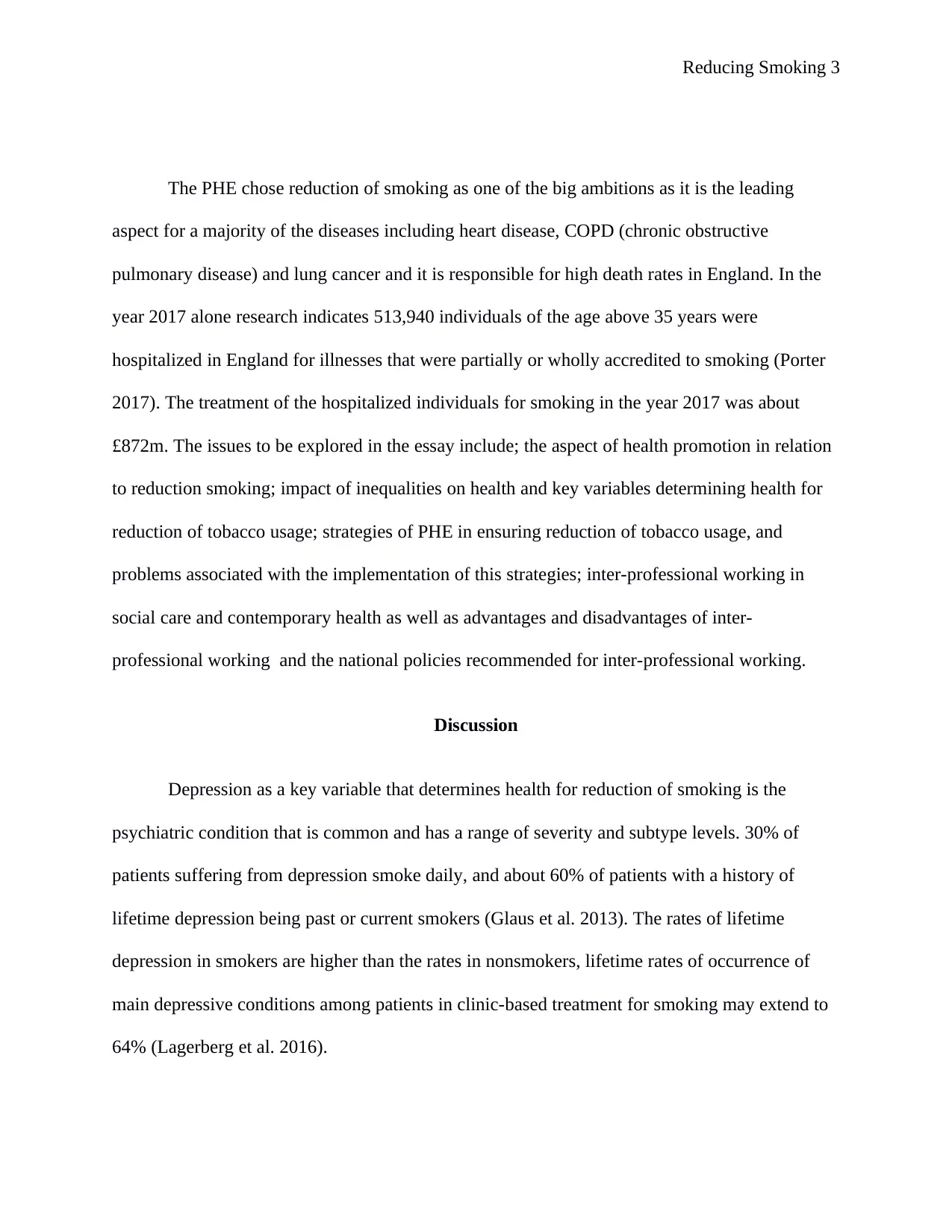
Reducing Smoking 3
The PHE chose reduction of smoking as one of the big ambitions as it is the leading
aspect for a majority of the diseases including heart disease, COPD (chronic obstructive
pulmonary disease) and lung cancer and it is responsible for high death rates in England. In the
year 2017 alone research indicates 513,940 individuals of the age above 35 years were
hospitalized in England for illnesses that were partially or wholly accredited to smoking (Porter
2017). The treatment of the hospitalized individuals for smoking in the year 2017 was about
£872m. The issues to be explored in the essay include; the aspect of health promotion in relation
to reduction smoking; impact of inequalities on health and key variables determining health for
reduction of tobacco usage; strategies of PHE in ensuring reduction of tobacco usage, and
problems associated with the implementation of this strategies; inter-professional working in
social care and contemporary health as well as advantages and disadvantages of inter-
professional working and the national policies recommended for inter-professional working.
Discussion
Depression as a key variable that determines health for reduction of smoking is the
psychiatric condition that is common and has a range of severity and subtype levels. 30% of
patients suffering from depression smoke daily, and about 60% of patients with a history of
lifetime depression being past or current smokers (Glaus et al. 2013). The rates of lifetime
depression in smokers are higher than the rates in nonsmokers, lifetime rates of occurrence of
main depressive conditions among patients in clinic-based treatment for smoking may extend to
64% (Lagerberg et al. 2016).
The PHE chose reduction of smoking as one of the big ambitions as it is the leading
aspect for a majority of the diseases including heart disease, COPD (chronic obstructive
pulmonary disease) and lung cancer and it is responsible for high death rates in England. In the
year 2017 alone research indicates 513,940 individuals of the age above 35 years were
hospitalized in England for illnesses that were partially or wholly accredited to smoking (Porter
2017). The treatment of the hospitalized individuals for smoking in the year 2017 was about
£872m. The issues to be explored in the essay include; the aspect of health promotion in relation
to reduction smoking; impact of inequalities on health and key variables determining health for
reduction of tobacco usage; strategies of PHE in ensuring reduction of tobacco usage, and
problems associated with the implementation of this strategies; inter-professional working in
social care and contemporary health as well as advantages and disadvantages of inter-
professional working and the national policies recommended for inter-professional working.
Discussion
Depression as a key variable that determines health for reduction of smoking is the
psychiatric condition that is common and has a range of severity and subtype levels. 30% of
patients suffering from depression smoke daily, and about 60% of patients with a history of
lifetime depression being past or current smokers (Glaus et al. 2013). The rates of lifetime
depression in smokers are higher than the rates in nonsmokers, lifetime rates of occurrence of
main depressive conditions among patients in clinic-based treatment for smoking may extend to
64% (Lagerberg et al. 2016).
⊘ This is a preview!⊘
Do you want full access?
Subscribe today to unlock all pages.

Trusted by 1+ million students worldwide
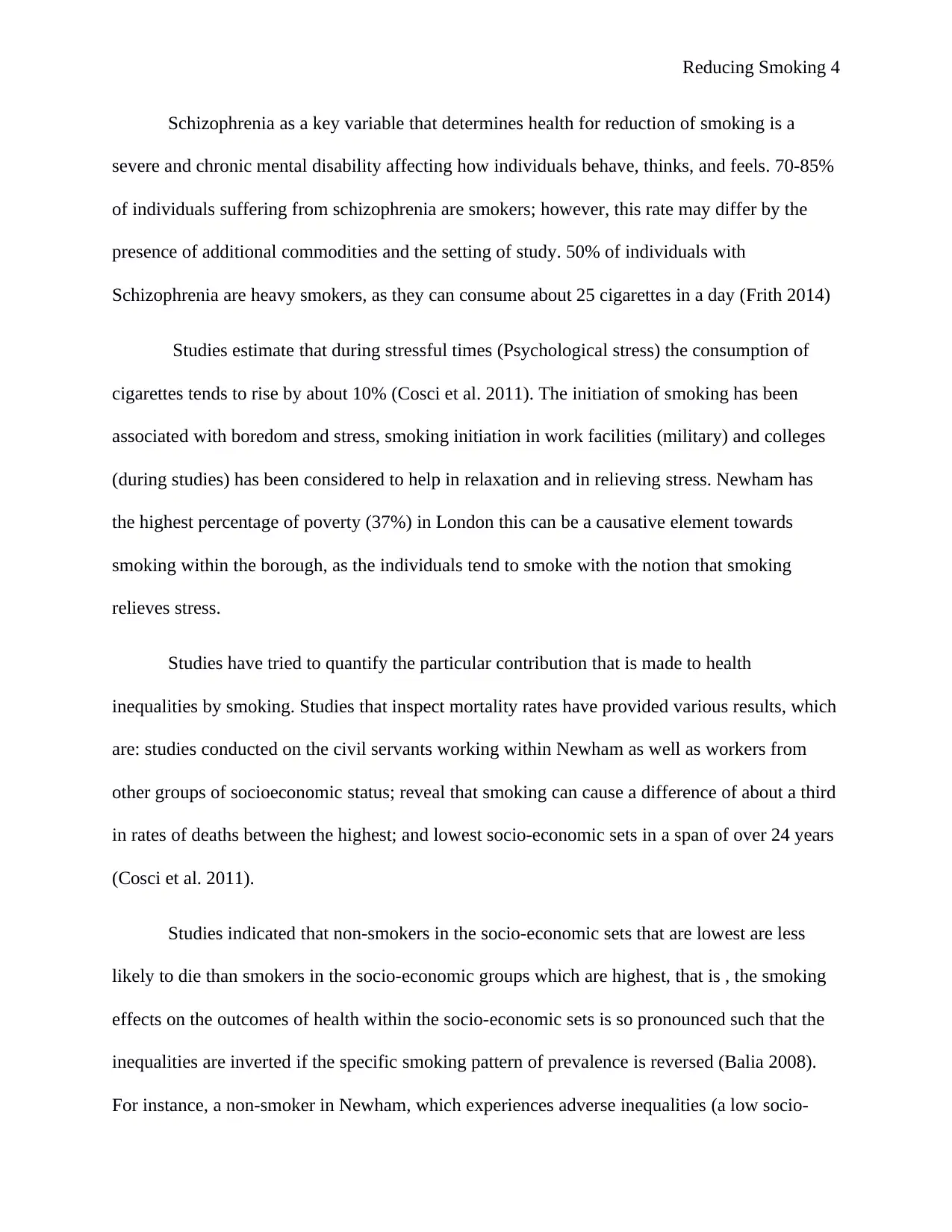
Reducing Smoking 4
Schizophrenia as a key variable that determines health for reduction of smoking is a
severe and chronic mental disability affecting how individuals behave, thinks, and feels. 70-85%
of individuals suffering from schizophrenia are smokers; however, this rate may differ by the
presence of additional commodities and the setting of study. 50% of individuals with
Schizophrenia are heavy smokers, as they can consume about 25 cigarettes in a day (Frith 2014)
Studies estimate that during stressful times (Psychological stress) the consumption of
cigarettes tends to rise by about 10% (Cosci et al. 2011). The initiation of smoking has been
associated with boredom and stress, smoking initiation in work facilities (military) and colleges
(during studies) has been considered to help in relaxation and in relieving stress. Newham has
the highest percentage of poverty (37%) in London this can be a causative element towards
smoking within the borough, as the individuals tend to smoke with the notion that smoking
relieves stress.
Studies have tried to quantify the particular contribution that is made to health
inequalities by smoking. Studies that inspect mortality rates have provided various results, which
are: studies conducted on the civil servants working within Newham as well as workers from
other groups of socioeconomic status; reveal that smoking can cause a difference of about a third
in rates of deaths between the highest; and lowest socio-economic sets in a span of over 24 years
(Cosci et al. 2011).
Studies indicated that non-smokers in the socio-economic sets that are lowest are less
likely to die than smokers in the socio-economic groups which are highest, that is , the smoking
effects on the outcomes of health within the socio-economic sets is so pronounced such that the
inequalities are inverted if the specific smoking pattern of prevalence is reversed (Balia 2008).
For instance, a non-smoker in Newham, which experiences adverse inequalities (a low socio-
Schizophrenia as a key variable that determines health for reduction of smoking is a
severe and chronic mental disability affecting how individuals behave, thinks, and feels. 70-85%
of individuals suffering from schizophrenia are smokers; however, this rate may differ by the
presence of additional commodities and the setting of study. 50% of individuals with
Schizophrenia are heavy smokers, as they can consume about 25 cigarettes in a day (Frith 2014)
Studies estimate that during stressful times (Psychological stress) the consumption of
cigarettes tends to rise by about 10% (Cosci et al. 2011). The initiation of smoking has been
associated with boredom and stress, smoking initiation in work facilities (military) and colleges
(during studies) has been considered to help in relaxation and in relieving stress. Newham has
the highest percentage of poverty (37%) in London this can be a causative element towards
smoking within the borough, as the individuals tend to smoke with the notion that smoking
relieves stress.
Studies have tried to quantify the particular contribution that is made to health
inequalities by smoking. Studies that inspect mortality rates have provided various results, which
are: studies conducted on the civil servants working within Newham as well as workers from
other groups of socioeconomic status; reveal that smoking can cause a difference of about a third
in rates of deaths between the highest; and lowest socio-economic sets in a span of over 24 years
(Cosci et al. 2011).
Studies indicated that non-smokers in the socio-economic sets that are lowest are less
likely to die than smokers in the socio-economic groups which are highest, that is , the smoking
effects on the outcomes of health within the socio-economic sets is so pronounced such that the
inequalities are inverted if the specific smoking pattern of prevalence is reversed (Balia 2008).
For instance, a non-smoker in Newham, which experiences adverse inequalities (a low socio-
Paraphrase This Document
Need a fresh take? Get an instant paraphrase of this document with our AI Paraphraser
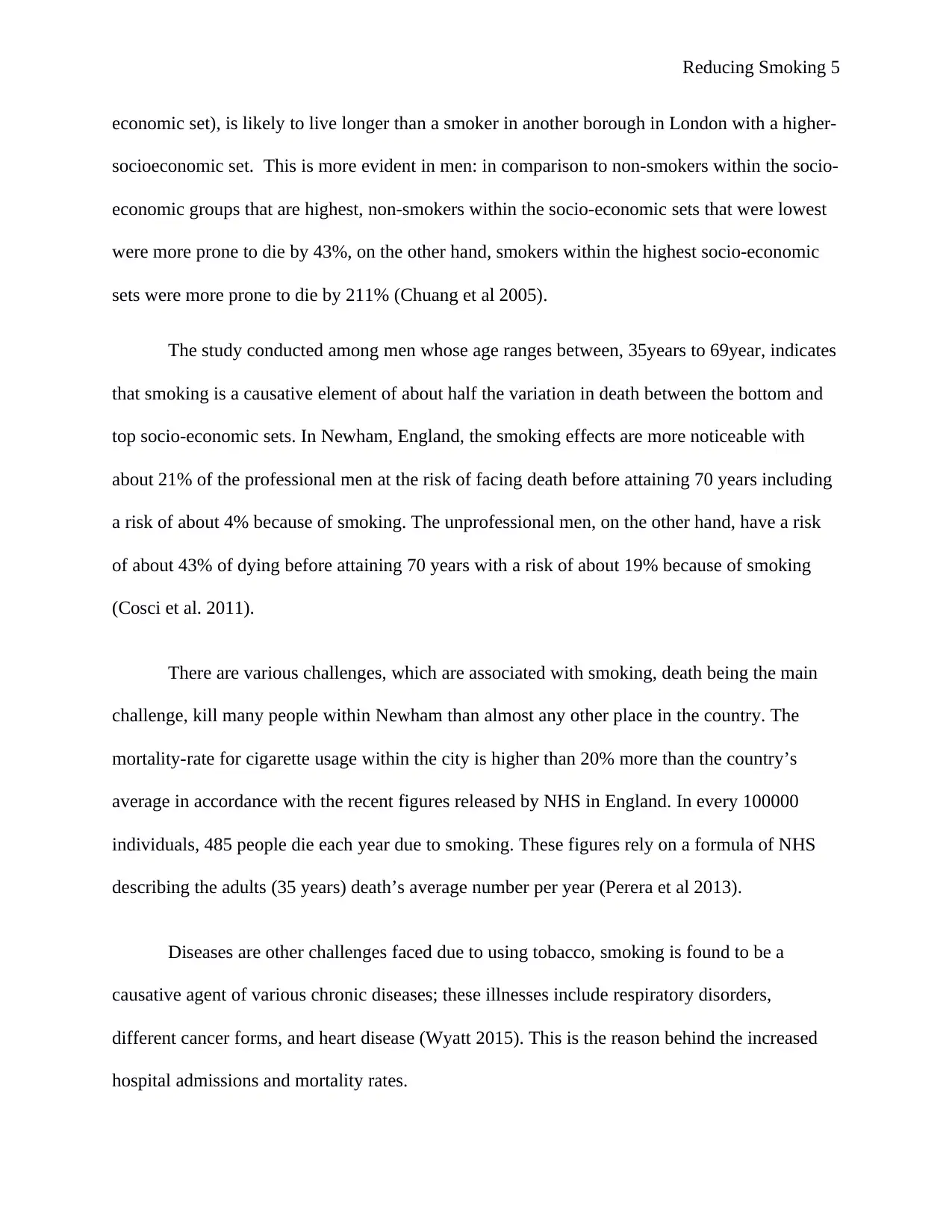
Reducing Smoking 5
economic set), is likely to live longer than a smoker in another borough in London with a higher-
socioeconomic set. This is more evident in men: in comparison to non-smokers within the socio-
economic groups that are highest, non-smokers within the socio-economic sets that were lowest
were more prone to die by 43%, on the other hand, smokers within the highest socio-economic
sets were more prone to die by 211% (Chuang et al 2005).
The study conducted among men whose age ranges between, 35years to 69year, indicates
that smoking is a causative element of about half the variation in death between the bottom and
top socio-economic sets. In Newham, England, the smoking effects are more noticeable with
about 21% of the professional men at the risk of facing death before attaining 70 years including
a risk of about 4% because of smoking. The unprofessional men, on the other hand, have a risk
of about 43% of dying before attaining 70 years with a risk of about 19% because of smoking
(Cosci et al. 2011).
There are various challenges, which are associated with smoking, death being the main
challenge, kill many people within Newham than almost any other place in the country. The
mortality-rate for cigarette usage within the city is higher than 20% more than the country’s
average in accordance with the recent figures released by NHS in England. In every 100000
individuals, 485 people die each year due to smoking. These figures rely on a formula of NHS
describing the adults (35 years) death’s average number per year (Perera et al 2013).
Diseases are other challenges faced due to using tobacco, smoking is found to be a
causative agent of various chronic diseases; these illnesses include respiratory disorders,
different cancer forms, and heart disease (Wyatt 2015). This is the reason behind the increased
hospital admissions and mortality rates.
economic set), is likely to live longer than a smoker in another borough in London with a higher-
socioeconomic set. This is more evident in men: in comparison to non-smokers within the socio-
economic groups that are highest, non-smokers within the socio-economic sets that were lowest
were more prone to die by 43%, on the other hand, smokers within the highest socio-economic
sets were more prone to die by 211% (Chuang et al 2005).
The study conducted among men whose age ranges between, 35years to 69year, indicates
that smoking is a causative element of about half the variation in death between the bottom and
top socio-economic sets. In Newham, England, the smoking effects are more noticeable with
about 21% of the professional men at the risk of facing death before attaining 70 years including
a risk of about 4% because of smoking. The unprofessional men, on the other hand, have a risk
of about 43% of dying before attaining 70 years with a risk of about 19% because of smoking
(Cosci et al. 2011).
There are various challenges, which are associated with smoking, death being the main
challenge, kill many people within Newham than almost any other place in the country. The
mortality-rate for cigarette usage within the city is higher than 20% more than the country’s
average in accordance with the recent figures released by NHS in England. In every 100000
individuals, 485 people die each year due to smoking. These figures rely on a formula of NHS
describing the adults (35 years) death’s average number per year (Perera et al 2013).
Diseases are other challenges faced due to using tobacco, smoking is found to be a
causative agent of various chronic diseases; these illnesses include respiratory disorders,
different cancer forms, and heart disease (Wyatt 2015). This is the reason behind the increased
hospital admissions and mortality rates.
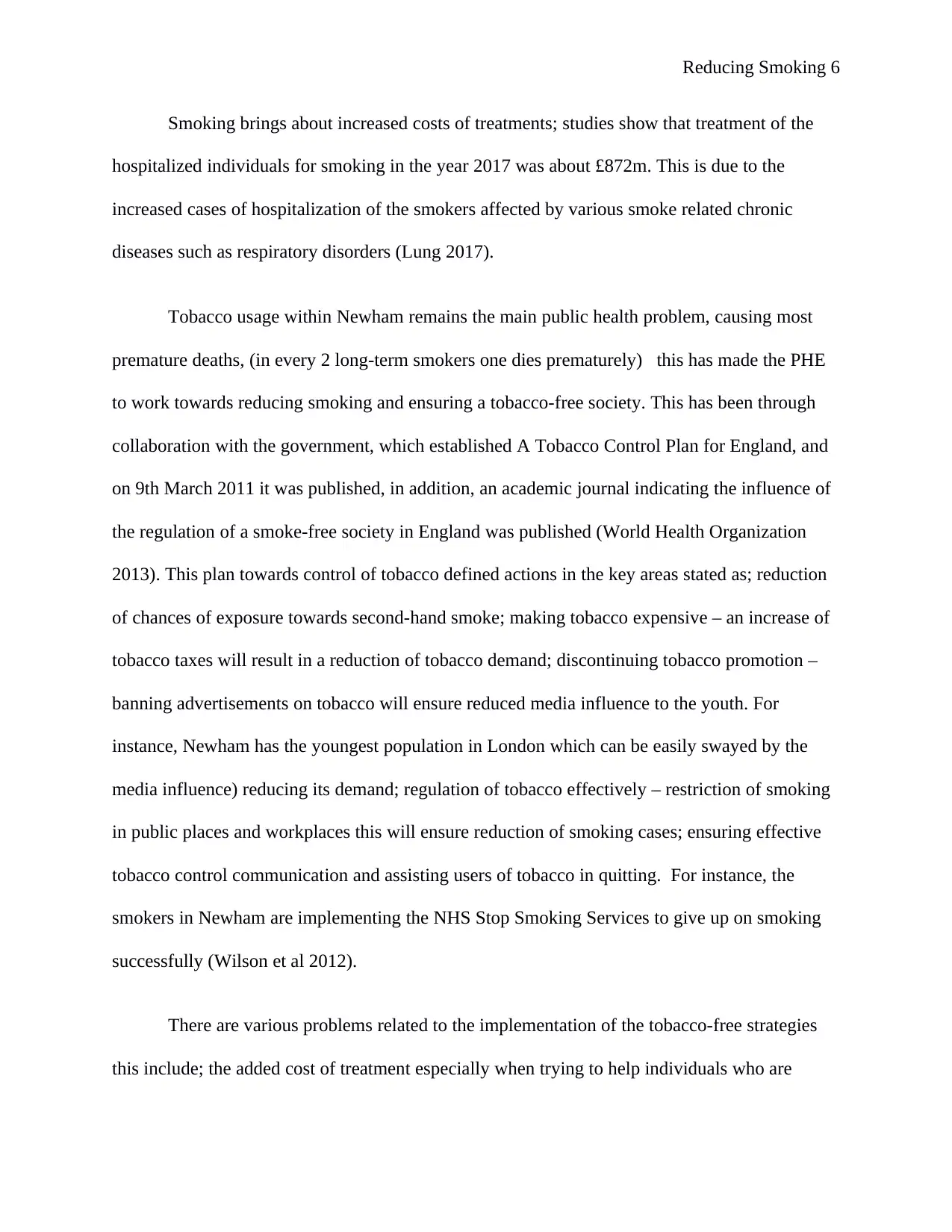
Reducing Smoking 6
Smoking brings about increased costs of treatments; studies show that treatment of the
hospitalized individuals for smoking in the year 2017 was about £872m. This is due to the
increased cases of hospitalization of the smokers affected by various smoke related chronic
diseases such as respiratory disorders (Lung 2017).
Tobacco usage within Newham remains the main public health problem, causing most
premature deaths, (in every 2 long-term smokers one dies prematurely) this has made the PHE
to work towards reducing smoking and ensuring a tobacco-free society. This has been through
collaboration with the government, which established A Tobacco Control Plan for England, and
on 9th March 2011 it was published, in addition, an academic journal indicating the influence of
the regulation of a smoke-free society in England was published (World Health Organization
2013). This plan towards control of tobacco defined actions in the key areas stated as; reduction
of chances of exposure towards second-hand smoke; making tobacco expensive – an increase of
tobacco taxes will result in a reduction of tobacco demand; discontinuing tobacco promotion –
banning advertisements on tobacco will ensure reduced media influence to the youth. For
instance, Newham has the youngest population in London which can be easily swayed by the
media influence) reducing its demand; regulation of tobacco effectively – restriction of smoking
in public places and workplaces this will ensure reduction of smoking cases; ensuring effective
tobacco control communication and assisting users of tobacco in quitting. For instance, the
smokers in Newham are implementing the NHS Stop Smoking Services to give up on smoking
successfully (Wilson et al 2012).
There are various problems related to the implementation of the tobacco-free strategies
this include; the added cost of treatment especially when trying to help individuals who are
Smoking brings about increased costs of treatments; studies show that treatment of the
hospitalized individuals for smoking in the year 2017 was about £872m. This is due to the
increased cases of hospitalization of the smokers affected by various smoke related chronic
diseases such as respiratory disorders (Lung 2017).
Tobacco usage within Newham remains the main public health problem, causing most
premature deaths, (in every 2 long-term smokers one dies prematurely) this has made the PHE
to work towards reducing smoking and ensuring a tobacco-free society. This has been through
collaboration with the government, which established A Tobacco Control Plan for England, and
on 9th March 2011 it was published, in addition, an academic journal indicating the influence of
the regulation of a smoke-free society in England was published (World Health Organization
2013). This plan towards control of tobacco defined actions in the key areas stated as; reduction
of chances of exposure towards second-hand smoke; making tobacco expensive – an increase of
tobacco taxes will result in a reduction of tobacco demand; discontinuing tobacco promotion –
banning advertisements on tobacco will ensure reduced media influence to the youth. For
instance, Newham has the youngest population in London which can be easily swayed by the
media influence) reducing its demand; regulation of tobacco effectively – restriction of smoking
in public places and workplaces this will ensure reduction of smoking cases; ensuring effective
tobacco control communication and assisting users of tobacco in quitting. For instance, the
smokers in Newham are implementing the NHS Stop Smoking Services to give up on smoking
successfully (Wilson et al 2012).
There are various problems related to the implementation of the tobacco-free strategies
this include; the added cost of treatment especially when trying to help individuals who are
⊘ This is a preview!⊘
Do you want full access?
Subscribe today to unlock all pages.

Trusted by 1+ million students worldwide
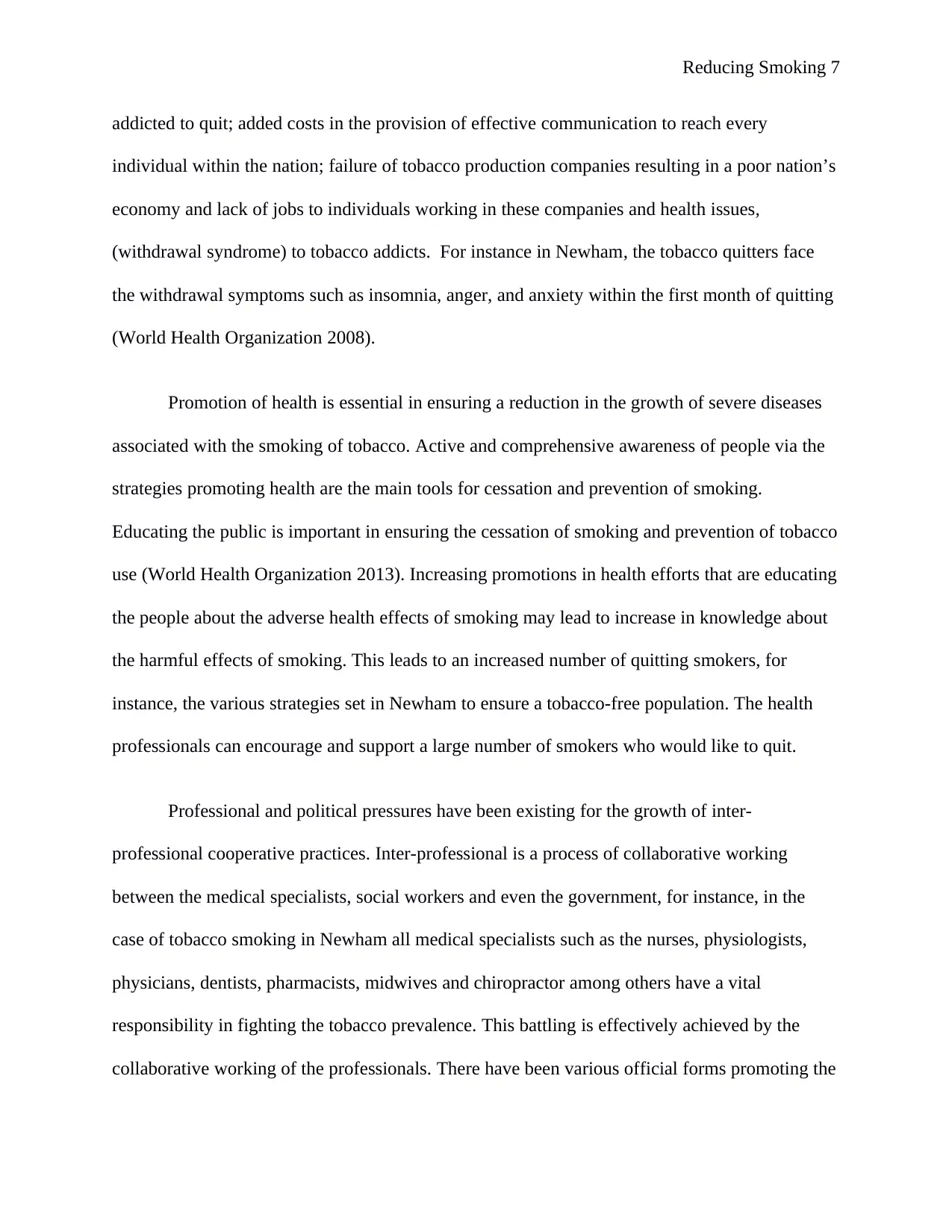
Reducing Smoking 7
addicted to quit; added costs in the provision of effective communication to reach every
individual within the nation; failure of tobacco production companies resulting in a poor nation’s
economy and lack of jobs to individuals working in these companies and health issues,
(withdrawal syndrome) to tobacco addicts. For instance in Newham, the tobacco quitters face
the withdrawal symptoms such as insomnia, anger, and anxiety within the first month of quitting
(World Health Organization 2008).
Promotion of health is essential in ensuring a reduction in the growth of severe diseases
associated with the smoking of tobacco. Active and comprehensive awareness of people via the
strategies promoting health are the main tools for cessation and prevention of smoking.
Educating the public is important in ensuring the cessation of smoking and prevention of tobacco
use (World Health Organization 2013). Increasing promotions in health efforts that are educating
the people about the adverse health effects of smoking may lead to increase in knowledge about
the harmful effects of smoking. This leads to an increased number of quitting smokers, for
instance, the various strategies set in Newham to ensure a tobacco-free population. The health
professionals can encourage and support a large number of smokers who would like to quit.
Professional and political pressures have been existing for the growth of inter-
professional cooperative practices. Inter-professional is a process of collaborative working
between the medical specialists, social workers and even the government, for instance, in the
case of tobacco smoking in Newham all medical specialists such as the nurses, physiologists,
physicians, dentists, pharmacists, midwives and chiropractor among others have a vital
responsibility in fighting the tobacco prevalence. This battling is effectively achieved by the
collaborative working of the professionals. There have been various official forms promoting the
addicted to quit; added costs in the provision of effective communication to reach every
individual within the nation; failure of tobacco production companies resulting in a poor nation’s
economy and lack of jobs to individuals working in these companies and health issues,
(withdrawal syndrome) to tobacco addicts. For instance in Newham, the tobacco quitters face
the withdrawal symptoms such as insomnia, anger, and anxiety within the first month of quitting
(World Health Organization 2008).
Promotion of health is essential in ensuring a reduction in the growth of severe diseases
associated with the smoking of tobacco. Active and comprehensive awareness of people via the
strategies promoting health are the main tools for cessation and prevention of smoking.
Educating the public is important in ensuring the cessation of smoking and prevention of tobacco
use (World Health Organization 2013). Increasing promotions in health efforts that are educating
the people about the adverse health effects of smoking may lead to increase in knowledge about
the harmful effects of smoking. This leads to an increased number of quitting smokers, for
instance, the various strategies set in Newham to ensure a tobacco-free population. The health
professionals can encourage and support a large number of smokers who would like to quit.
Professional and political pressures have been existing for the growth of inter-
professional cooperative practices. Inter-professional is a process of collaborative working
between the medical specialists, social workers and even the government, for instance, in the
case of tobacco smoking in Newham all medical specialists such as the nurses, physiologists,
physicians, dentists, pharmacists, midwives and chiropractor among others have a vital
responsibility in fighting the tobacco prevalence. This battling is effectively achieved by the
collaborative working of the professionals. There have been various official forms promoting the
Paraphrase This Document
Need a fresh take? Get an instant paraphrase of this document with our AI Paraphraser
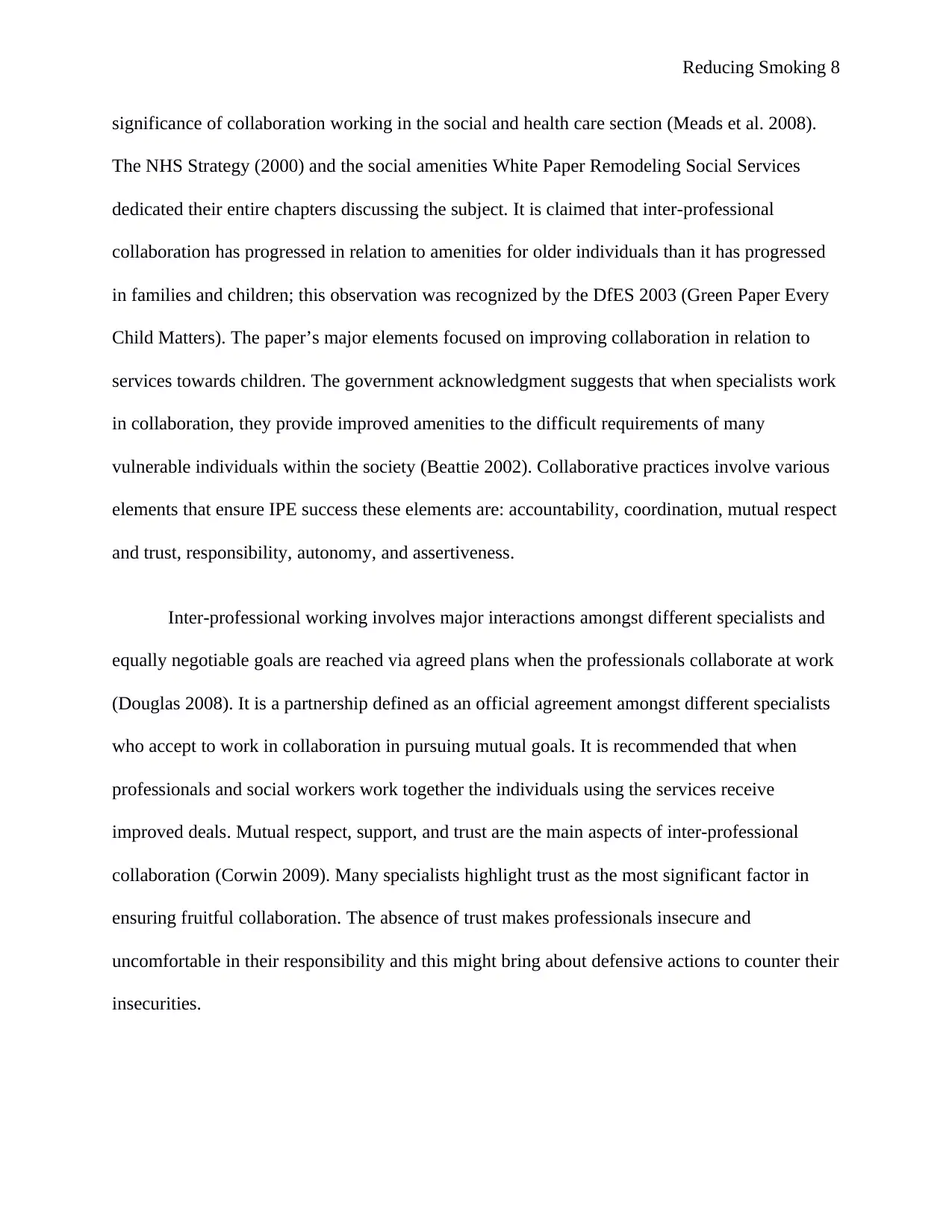
Reducing Smoking 8
significance of collaboration working in the social and health care section (Meads et al. 2008).
The NHS Strategy (2000) and the social amenities White Paper Remodeling Social Services
dedicated their entire chapters discussing the subject. It is claimed that inter-professional
collaboration has progressed in relation to amenities for older individuals than it has progressed
in families and children; this observation was recognized by the DfES 2003 (Green Paper Every
Child Matters). The paper’s major elements focused on improving collaboration in relation to
services towards children. The government acknowledgment suggests that when specialists work
in collaboration, they provide improved amenities to the difficult requirements of many
vulnerable individuals within the society (Beattie 2002). Collaborative practices involve various
elements that ensure IPE success these elements are: accountability, coordination, mutual respect
and trust, responsibility, autonomy, and assertiveness.
Inter-professional working involves major interactions amongst different specialists and
equally negotiable goals are reached via agreed plans when the professionals collaborate at work
(Douglas 2008). It is a partnership defined as an official agreement amongst different specialists
who accept to work in collaboration in pursuing mutual goals. It is recommended that when
professionals and social workers work together the individuals using the services receive
improved deals. Mutual respect, support, and trust are the main aspects of inter-professional
collaboration (Corwin 2009). Many specialists highlight trust as the most significant factor in
ensuring fruitful collaboration. The absence of trust makes professionals insecure and
uncomfortable in their responsibility and this might bring about defensive actions to counter their
insecurities.
significance of collaboration working in the social and health care section (Meads et al. 2008).
The NHS Strategy (2000) and the social amenities White Paper Remodeling Social Services
dedicated their entire chapters discussing the subject. It is claimed that inter-professional
collaboration has progressed in relation to amenities for older individuals than it has progressed
in families and children; this observation was recognized by the DfES 2003 (Green Paper Every
Child Matters). The paper’s major elements focused on improving collaboration in relation to
services towards children. The government acknowledgment suggests that when specialists work
in collaboration, they provide improved amenities to the difficult requirements of many
vulnerable individuals within the society (Beattie 2002). Collaborative practices involve various
elements that ensure IPE success these elements are: accountability, coordination, mutual respect
and trust, responsibility, autonomy, and assertiveness.
Inter-professional working involves major interactions amongst different specialists and
equally negotiable goals are reached via agreed plans when the professionals collaborate at work
(Douglas 2008). It is a partnership defined as an official agreement amongst different specialists
who accept to work in collaboration in pursuing mutual goals. It is recommended that when
professionals and social workers work together the individuals using the services receive
improved deals. Mutual respect, support, and trust are the main aspects of inter-professional
collaboration (Corwin 2009). Many specialists highlight trust as the most significant factor in
ensuring fruitful collaboration. The absence of trust makes professionals insecure and
uncomfortable in their responsibility and this might bring about defensive actions to counter their
insecurities.
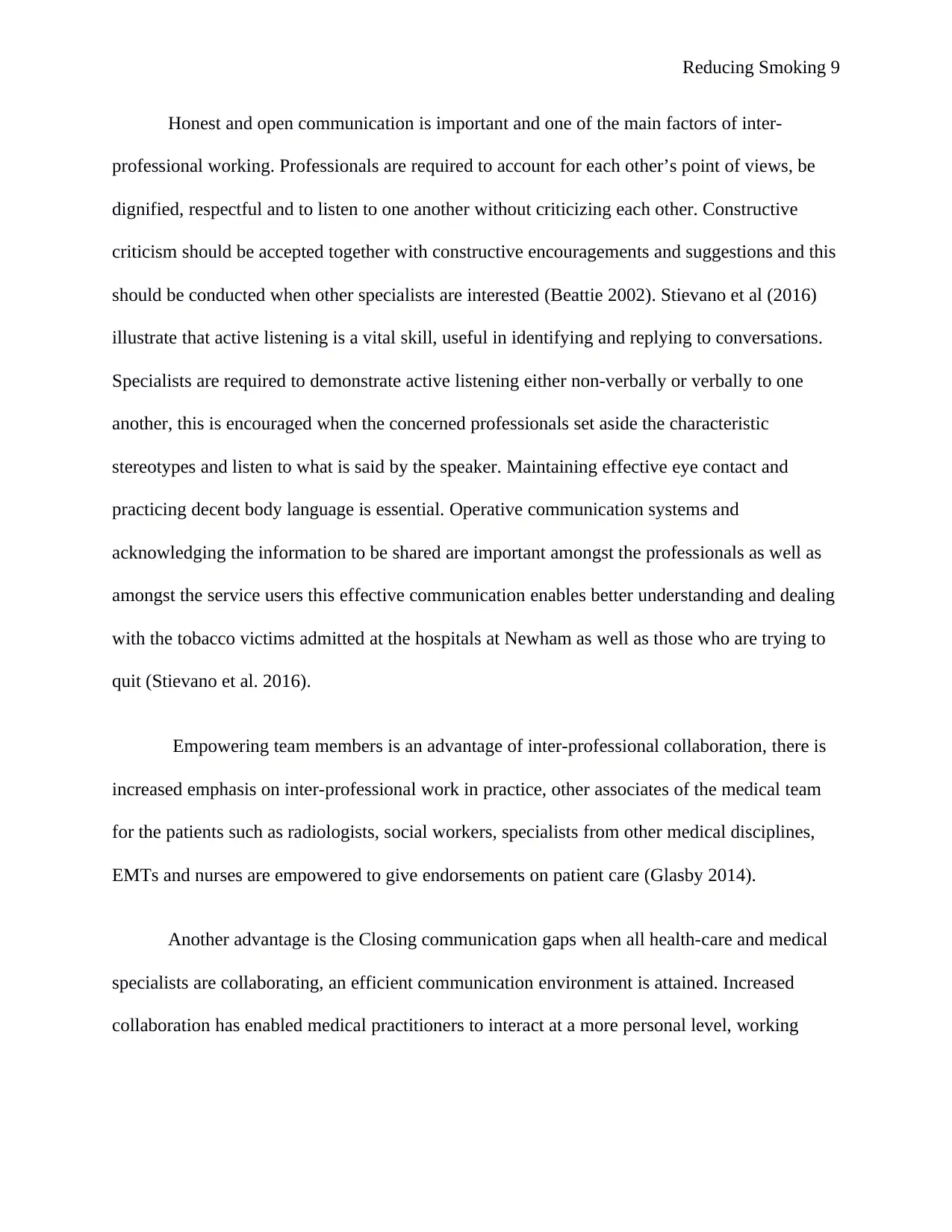
Reducing Smoking 9
Honest and open communication is important and one of the main factors of inter-
professional working. Professionals are required to account for each other’s point of views, be
dignified, respectful and to listen to one another without criticizing each other. Constructive
criticism should be accepted together with constructive encouragements and suggestions and this
should be conducted when other specialists are interested (Beattie 2002). Stievano et al (2016)
illustrate that active listening is a vital skill, useful in identifying and replying to conversations.
Specialists are required to demonstrate active listening either non-verbally or verbally to one
another, this is encouraged when the concerned professionals set aside the characteristic
stereotypes and listen to what is said by the speaker. Maintaining effective eye contact and
practicing decent body language is essential. Operative communication systems and
acknowledging the information to be shared are important amongst the professionals as well as
amongst the service users this effective communication enables better understanding and dealing
with the tobacco victims admitted at the hospitals at Newham as well as those who are trying to
quit (Stievano et al. 2016).
Empowering team members is an advantage of inter-professional collaboration, there is
increased emphasis on inter-professional work in practice, other associates of the medical team
for the patients such as radiologists, social workers, specialists from other medical disciplines,
EMTs and nurses are empowered to give endorsements on patient care (Glasby 2014).
Another advantage is the Closing communication gaps when all health-care and medical
specialists are collaborating, an efficient communication environment is attained. Increased
collaboration has enabled medical practitioners to interact at a more personal level, working
Honest and open communication is important and one of the main factors of inter-
professional working. Professionals are required to account for each other’s point of views, be
dignified, respectful and to listen to one another without criticizing each other. Constructive
criticism should be accepted together with constructive encouragements and suggestions and this
should be conducted when other specialists are interested (Beattie 2002). Stievano et al (2016)
illustrate that active listening is a vital skill, useful in identifying and replying to conversations.
Specialists are required to demonstrate active listening either non-verbally or verbally to one
another, this is encouraged when the concerned professionals set aside the characteristic
stereotypes and listen to what is said by the speaker. Maintaining effective eye contact and
practicing decent body language is essential. Operative communication systems and
acknowledging the information to be shared are important amongst the professionals as well as
amongst the service users this effective communication enables better understanding and dealing
with the tobacco victims admitted at the hospitals at Newham as well as those who are trying to
quit (Stievano et al. 2016).
Empowering team members is an advantage of inter-professional collaboration, there is
increased emphasis on inter-professional work in practice, other associates of the medical team
for the patients such as radiologists, social workers, specialists from other medical disciplines,
EMTs and nurses are empowered to give endorsements on patient care (Glasby 2014).
Another advantage is the Closing communication gaps when all health-care and medical
specialists are collaborating, an efficient communication environment is attained. Increased
collaboration has enabled medical practitioners to interact at a more personal level, working
⊘ This is a preview!⊘
Do you want full access?
Subscribe today to unlock all pages.

Trusted by 1+ million students worldwide
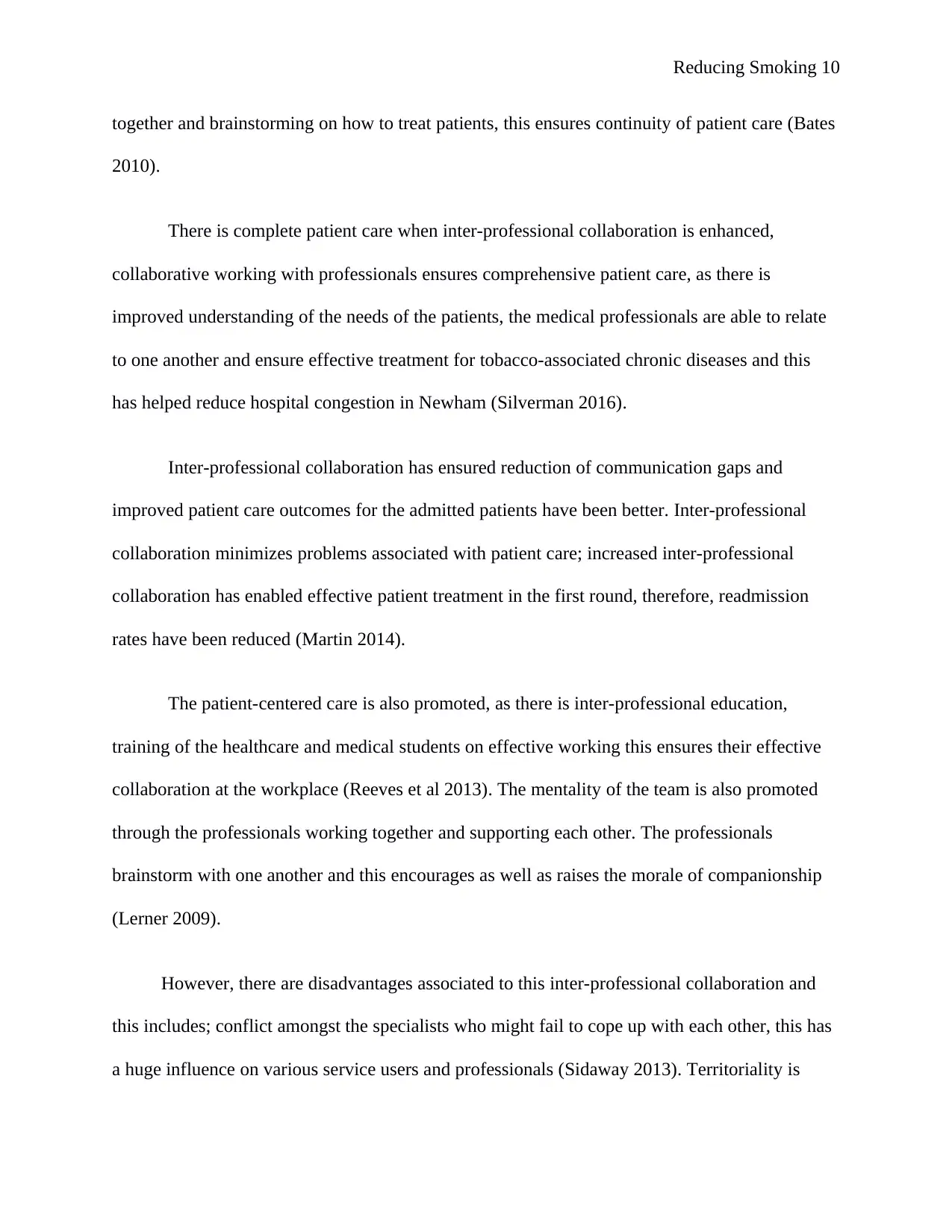
Reducing Smoking 10
together and brainstorming on how to treat patients, this ensures continuity of patient care (Bates
2010).
There is complete patient care when inter-professional collaboration is enhanced,
collaborative working with professionals ensures comprehensive patient care, as there is
improved understanding of the needs of the patients, the medical professionals are able to relate
to one another and ensure effective treatment for tobacco-associated chronic diseases and this
has helped reduce hospital congestion in Newham (Silverman 2016).
Inter-professional collaboration has ensured reduction of communication gaps and
improved patient care outcomes for the admitted patients have been better. Inter-professional
collaboration minimizes problems associated with patient care; increased inter-professional
collaboration has enabled effective patient treatment in the first round, therefore, readmission
rates have been reduced (Martin 2014).
The patient-centered care is also promoted, as there is inter-professional education,
training of the healthcare and medical students on effective working this ensures their effective
collaboration at the workplace (Reeves et al 2013). The mentality of the team is also promoted
through the professionals working together and supporting each other. The professionals
brainstorm with one another and this encourages as well as raises the morale of companionship
(Lerner 2009).
However, there are disadvantages associated to this inter-professional collaboration and
this includes; conflict amongst the specialists who might fail to cope up with each other, this has
a huge influence on various service users and professionals (Sidaway 2013). Territoriality is
together and brainstorming on how to treat patients, this ensures continuity of patient care (Bates
2010).
There is complete patient care when inter-professional collaboration is enhanced,
collaborative working with professionals ensures comprehensive patient care, as there is
improved understanding of the needs of the patients, the medical professionals are able to relate
to one another and ensure effective treatment for tobacco-associated chronic diseases and this
has helped reduce hospital congestion in Newham (Silverman 2016).
Inter-professional collaboration has ensured reduction of communication gaps and
improved patient care outcomes for the admitted patients have been better. Inter-professional
collaboration minimizes problems associated with patient care; increased inter-professional
collaboration has enabled effective patient treatment in the first round, therefore, readmission
rates have been reduced (Martin 2014).
The patient-centered care is also promoted, as there is inter-professional education,
training of the healthcare and medical students on effective working this ensures their effective
collaboration at the workplace (Reeves et al 2013). The mentality of the team is also promoted
through the professionals working together and supporting each other. The professionals
brainstorm with one another and this encourages as well as raises the morale of companionship
(Lerner 2009).
However, there are disadvantages associated to this inter-professional collaboration and
this includes; conflict amongst the specialists who might fail to cope up with each other, this has
a huge influence on various service users and professionals (Sidaway 2013). Territoriality is
Paraphrase This Document
Need a fresh take? Get an instant paraphrase of this document with our AI Paraphraser
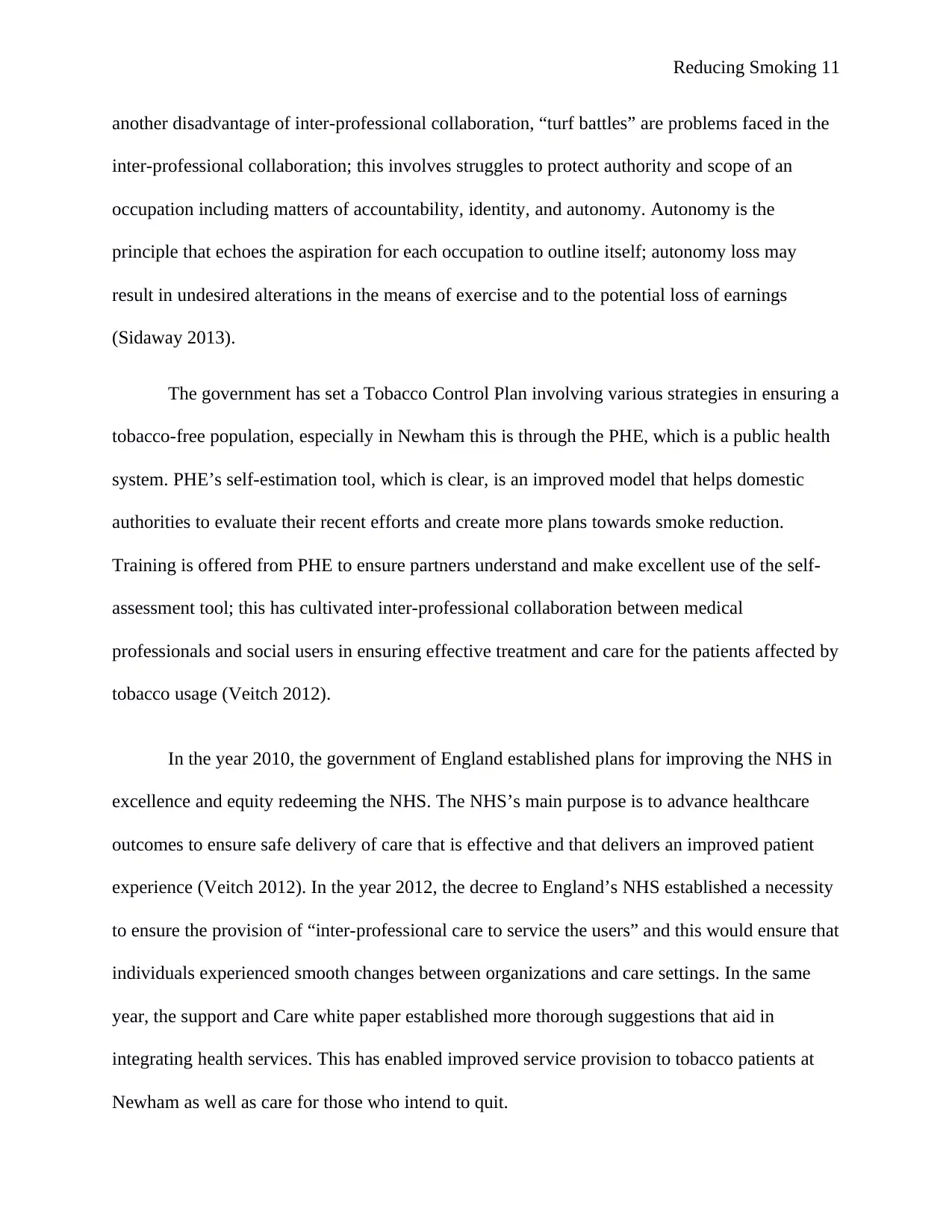
Reducing Smoking 11
another disadvantage of inter-professional collaboration, “turf battles” are problems faced in the
inter-professional collaboration; this involves struggles to protect authority and scope of an
occupation including matters of accountability, identity, and autonomy. Autonomy is the
principle that echoes the aspiration for each occupation to outline itself; autonomy loss may
result in undesired alterations in the means of exercise and to the potential loss of earnings
(Sidaway 2013).
The government has set a Tobacco Control Plan involving various strategies in ensuring a
tobacco-free population, especially in Newham this is through the PHE, which is a public health
system. PHE’s self-estimation tool, which is clear, is an improved model that helps domestic
authorities to evaluate their recent efforts and create more plans towards smoke reduction.
Training is offered from PHE to ensure partners understand and make excellent use of the self-
assessment tool; this has cultivated inter-professional collaboration between medical
professionals and social users in ensuring effective treatment and care for the patients affected by
tobacco usage (Veitch 2012).
In the year 2010, the government of England established plans for improving the NHS in
excellence and equity redeeming the NHS. The NHS’s main purpose is to advance healthcare
outcomes to ensure safe delivery of care that is effective and that delivers an improved patient
experience (Veitch 2012). In the year 2012, the decree to England’s NHS established a necessity
to ensure the provision of “inter-professional care to service the users” and this would ensure that
individuals experienced smooth changes between organizations and care settings. In the same
year, the support and Care white paper established more thorough suggestions that aid in
integrating health services. This has enabled improved service provision to tobacco patients at
Newham as well as care for those who intend to quit.
another disadvantage of inter-professional collaboration, “turf battles” are problems faced in the
inter-professional collaboration; this involves struggles to protect authority and scope of an
occupation including matters of accountability, identity, and autonomy. Autonomy is the
principle that echoes the aspiration for each occupation to outline itself; autonomy loss may
result in undesired alterations in the means of exercise and to the potential loss of earnings
(Sidaway 2013).
The government has set a Tobacco Control Plan involving various strategies in ensuring a
tobacco-free population, especially in Newham this is through the PHE, which is a public health
system. PHE’s self-estimation tool, which is clear, is an improved model that helps domestic
authorities to evaluate their recent efforts and create more plans towards smoke reduction.
Training is offered from PHE to ensure partners understand and make excellent use of the self-
assessment tool; this has cultivated inter-professional collaboration between medical
professionals and social users in ensuring effective treatment and care for the patients affected by
tobacco usage (Veitch 2012).
In the year 2010, the government of England established plans for improving the NHS in
excellence and equity redeeming the NHS. The NHS’s main purpose is to advance healthcare
outcomes to ensure safe delivery of care that is effective and that delivers an improved patient
experience (Veitch 2012). In the year 2012, the decree to England’s NHS established a necessity
to ensure the provision of “inter-professional care to service the users” and this would ensure that
individuals experienced smooth changes between organizations and care settings. In the same
year, the support and Care white paper established more thorough suggestions that aid in
integrating health services. This has enabled improved service provision to tobacco patients at
Newham as well as care for those who intend to quit.
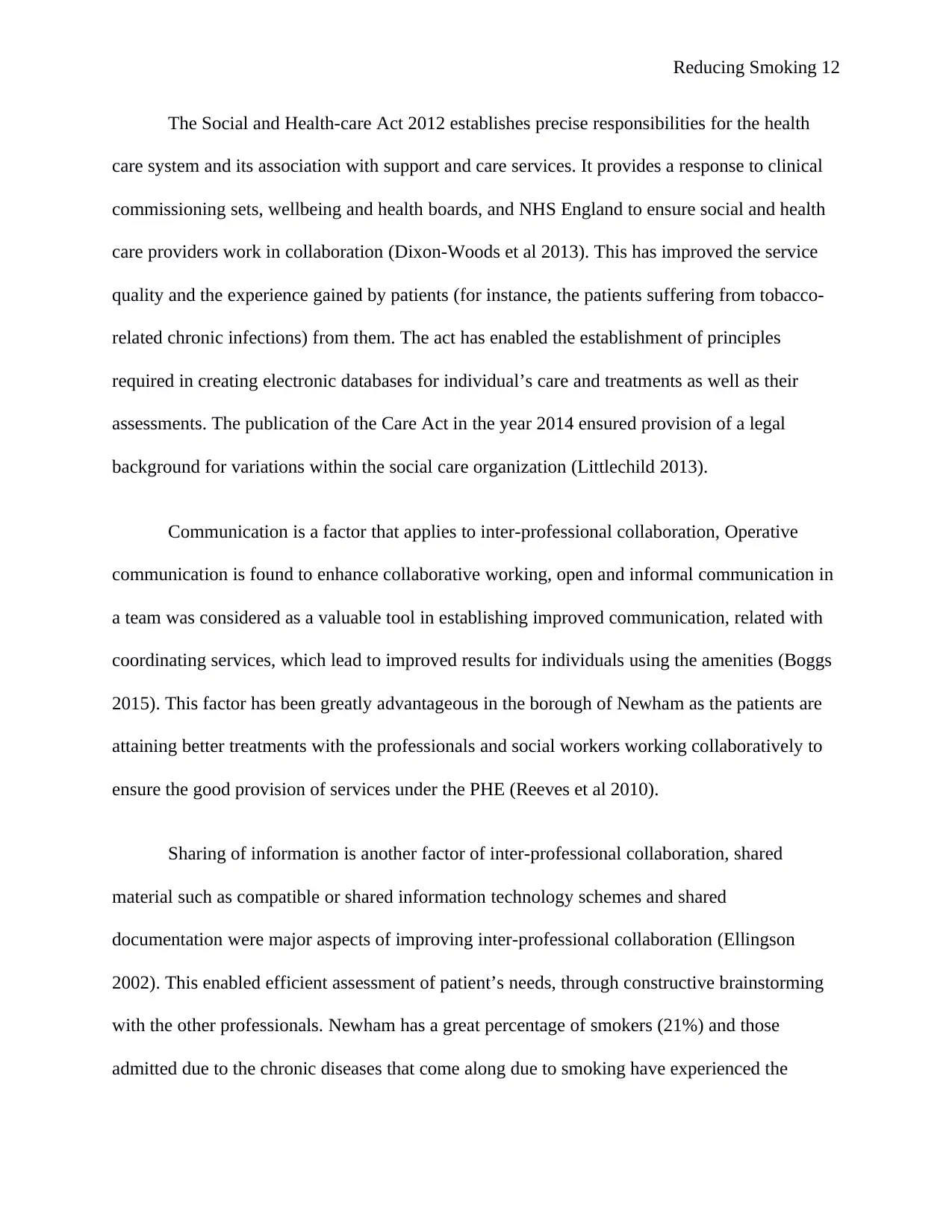
Reducing Smoking 12
The Social and Health-care Act 2012 establishes precise responsibilities for the health
care system and its association with support and care services. It provides a response to clinical
commissioning sets, wellbeing and health boards, and NHS England to ensure social and health
care providers work in collaboration (Dixon-Woods et al 2013). This has improved the service
quality and the experience gained by patients (for instance, the patients suffering from tobacco-
related chronic infections) from them. The act has enabled the establishment of principles
required in creating electronic databases for individual’s care and treatments as well as their
assessments. The publication of the Care Act in the year 2014 ensured provision of a legal
background for variations within the social care organization (Littlechild 2013).
Communication is a factor that applies to inter-professional collaboration, Operative
communication is found to enhance collaborative working, open and informal communication in
a team was considered as a valuable tool in establishing improved communication, related with
coordinating services, which lead to improved results for individuals using the amenities (Boggs
2015). This factor has been greatly advantageous in the borough of Newham as the patients are
attaining better treatments with the professionals and social workers working collaboratively to
ensure the good provision of services under the PHE (Reeves et al 2010).
Sharing of information is another factor of inter-professional collaboration, shared
material such as compatible or shared information technology schemes and shared
documentation were major aspects of improving inter-professional collaboration (Ellingson
2002). This enabled efficient assessment of patient’s needs, through constructive brainstorming
with the other professionals. Newham has a great percentage of smokers (21%) and those
admitted due to the chronic diseases that come along due to smoking have experienced the
The Social and Health-care Act 2012 establishes precise responsibilities for the health
care system and its association with support and care services. It provides a response to clinical
commissioning sets, wellbeing and health boards, and NHS England to ensure social and health
care providers work in collaboration (Dixon-Woods et al 2013). This has improved the service
quality and the experience gained by patients (for instance, the patients suffering from tobacco-
related chronic infections) from them. The act has enabled the establishment of principles
required in creating electronic databases for individual’s care and treatments as well as their
assessments. The publication of the Care Act in the year 2014 ensured provision of a legal
background for variations within the social care organization (Littlechild 2013).
Communication is a factor that applies to inter-professional collaboration, Operative
communication is found to enhance collaborative working, open and informal communication in
a team was considered as a valuable tool in establishing improved communication, related with
coordinating services, which lead to improved results for individuals using the amenities (Boggs
2015). This factor has been greatly advantageous in the borough of Newham as the patients are
attaining better treatments with the professionals and social workers working collaboratively to
ensure the good provision of services under the PHE (Reeves et al 2010).
Sharing of information is another factor of inter-professional collaboration, shared
material such as compatible or shared information technology schemes and shared
documentation were major aspects of improving inter-professional collaboration (Ellingson
2002). This enabled efficient assessment of patient’s needs, through constructive brainstorming
with the other professionals. Newham has a great percentage of smokers (21%) and those
admitted due to the chronic diseases that come along due to smoking have experienced the
⊘ This is a preview!⊘
Do you want full access?
Subscribe today to unlock all pages.

Trusted by 1+ million students worldwide
1 out of 20
Related Documents
Your All-in-One AI-Powered Toolkit for Academic Success.
+13062052269
info@desklib.com
Available 24*7 on WhatsApp / Email
![[object Object]](/_next/static/media/star-bottom.7253800d.svg)
Unlock your academic potential
Copyright © 2020–2025 A2Z Services. All Rights Reserved. Developed and managed by ZUCOL.


